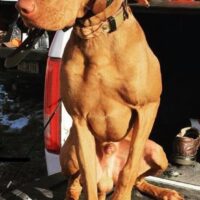Woodcock banding in the spring, over pointing dogs, is an upland game bird aficionado’s dream come true. You witness fine bird dogs executing a high level of bird handling finesse. You explore new woodland habitats. You challenge your bird finding skills. You hold live birds. And, you help to expand scientific knowledge about an important upland bird. It just doesn’t get any better than that, and volunteer banders in Michigan get to do it every spring.
The Michigan Department of Natural Resources (DNR) has conducted a spring American woodcock banding program since 1960. The program recruits and trains volunteer banders, who use pointing dogs to find adult woodcock hens and chicks in April. May and June. lt‘s the largest woodcock banding pro-gram. having banded about 20,000 more birds than the next largest effort — Maine — since 1981. More American woodcock chicks are banded in Michigan than anywhere else on Earth. For more than half a century, woodcock researchers have acknowledged the value of woodcock banding. ln 1943, Mendell and Aldous noted that banding woodcock should be part of any management program for the species. They also determined that the most effective capture method in Maine was to locate broods with trained bird dogs. Liscinsky in 1962 suggested that data from woodcock banding was the primary source of information used to acquire knowledge about the birds’ movement and migration. Sheldon stated in 1967 that extensive banding is required to help interpret the population omposition of the fall kill as revealed by annual wing collection.
In Michigan. Andy Ammann reported in 1973 that brood banding appeared to be more efficient than other known method, about twice as productive as mist netting or night lighting. In 1982, Dwyer and Nichols noted that poor banding and recovery data have always been a problem in the investigations of woodcock population dynamics. Owen et al. (1977) and McCabe (1982) also identified the high cost and dificulty of banding adequate numbers of woodcock as a problem.
More recently, research biologists Krementz and Bruggink noted that the low number of woodcock banding programs following the late 1970s in the Eastern Region and the early 1980s in the Central Region have hindered management decisions.
 Woodcock authorities note that a nationally expanded woodcock banding program would increase our knowledge of how annual harvest and survival influence woodcock demographics. The Michigan banding program. having one of the most consistent long-term samples of woodcock banding information anywhere, could be the prototype for such a program.
Woodcock authorities note that a nationally expanded woodcock banding program would increase our knowledge of how annual harvest and survival influence woodcock demographics. The Michigan banding program. having one of the most consistent long-term samples of woodcock banding information anywhere, could be the prototype for such a program.
Michigan banders are a very motivated and dedicated group of woodcock supporters. They must qualify each year for a DNR banding permit. And, the DNR annually assesses each one of them on criteria like attendance at the most recent mandatory training session, a satisfactory rating for previous banding efforts, maintenance of accurate annual banding records, and submission of handing records to the DNR prior to July] . (The banding authorization is valid from April l—July 1.)
Prospective banders must apprentice with an established bander for at least one field season. A volunteer coordinator with banding knowledge helps to make the mentor-apprentice contacts. The sponsor must submit a letter of recommendation to the DNR to qualify the potential new bander for a future banding permit.The new bander also mist attend the mandatory training session and abide by permit stipulations.
The DNR hosts a mandatory woodcock bander’s training session in April of odd numbered years to keep volunteer banders current in brood banding techniques, banding requirements and Woodcock biology. In even-numbered years, a non-mandatory summer bander’s picnic is held in July to discuss banding activities. The banders organize the summer meeting. Both meetings allow for an exchange of ideas and input on methods to improve the program. In years when the mandatory training is not conducted, banders are surveyed to confirm their interest in continued participation and to provide them with current-year banding information.
The biennial mandatory training session reinforces bander responsibilities and educates volunteers about current issues pertaining to woodcock. Each topic meets a specific educational objective designed to maintain a high level of bander competency. Core agenda items are record-keeping and banding technique. Maintenance of accurate banding records is stressed. Sample banding forms are provided for review and banders are taught or reminded how to complete the documents.
Participants are also taught how to determine banding location coordinates and are tested on their map reading skills. Because most people are familiar with township, range. and section, the program asks them to report their locations using that format. When the data is entered for the U.S. Geological Survey Bird Banding Laboratory, the locations are converted into the appropriate 10-minute block.
Banding techniques are highlighted through classroom discussion and handson activities. Capture myopathy is defined, and students learn to prevent chick mortality. A quail chick banding exercise replicates banding woodcock chicks in the field. Banders report that they are more aware of the potential for handling myopathy and that they work to reduce mortality associated with capture because of the training.
During the training session, attendees are encouraged to share banding tips and methods to streamline banding activities. They also are polled on ways to strengthen the banding program and training curriculum.
After the banding season, DNR staff review banding forms submitted by banders and submit banding data to the USGS Bird Banding Laboratory in Laurel, Md. State banding information is analyzed by DNR personnel and included in woodcock management documents developed for the agency. An annual Woodcock Bander‘s Newsletter is produced to document yearly banding activities and cursory seasonal banding observations. The newsletter also serves as a tool to communicate with banders and others about woodcock management.
In addition, a restricted web site is available for the DNR and Michigan banders to share comments and observations. Trained volunteers have been critical to banding efforts in Michigan. They’ve implemented an effective and efflcient banding program without encumbering the agency. They’ve banded more woodcock in Michigan than in any other state, growing from a limited number of birds banded in 1965 to about 1,000 per year. The number of active banders in the program also has increased. from six in l965 to nearly 100 last year.
In 2010, Michigan banders spent about 1.800 hours afield and banded about 800 chicks. The average brood size observed was about three chicks. There were about 64 chicks observed and about 46 chicks banded per 100 hours of search time, compared to about 83 chicks observed and 55 chicks banded per 100 hours in 2009. In 2011 banders spent about 1,800 hours afield and banded about 700 chicks. There were about 55 chicks observed and about 41 chicks banded per [00 hours of search time.
Michigan banding efforts have proven invaluable in providing large sample sizes for woodcock researchers to analyze in developing better understanding of woodcock ecology. which in North America depends on local and international influences that affect population dynamics. To understand those dynamics. woodcock investigators and managers have identified the need for increased banding efforts throughout the woodcock range.
Continued banding of local birds in Michigan and expanded banding in other production areas may prove helpful as biologists study the impacts of harvest and habitat conditions on woodcock populations. In addition, information collected by banders such as woodcock chicks observed per 100 hours of search time may be useful as an index of local woodcock production trends.
As greater emphasis is placed on handing woodcock throughout their breeding range. the Michigan banding program can serve as a template for others agencies to emulate. The large number of birds banded through the Michigan program and the efficiency of the trained Michigan volunteers prove that it can be done.
The bander of Michigan encourage all woodcock devotees to get involved in a banding program. Although most Michigan banders are avid woodcock hunters, they say they would trade fall hunting for spring banding if they had to make a choice.
Note from Buy and Sell Hunting Dogs: We would like to Thank Al Stewart from the Michigan Dept. of Natural Resources and Woodcock Limited for their help in promoting Woodcock Banding and Upland Game Bird Management.












Speak Your Mind